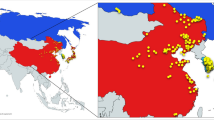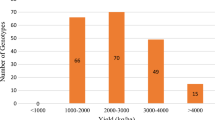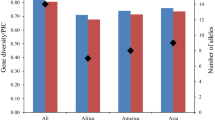Abstract
The wild soybean, an annual self-pollinating plant, is the progenitor of soybeans and is extensively distributed in the Far East of Russia, the Korea peninsula, China and Japan. Geographically, Japan is surrounded by sea and insulated from China. We preliminarily evaluate whether the Japanese and Chinese wild soybean germplasm pools are genetically differentiated from each other using SSR markers. The results showed that the two pools have great genetic differentiation. Some loci presented obvious differences in mean genetic divergence (G ST) value between the two pools. The G ST among the geographic regions in China was higher than that in Japan. The average within-geographic region gene diversity values (H S) in the two pools were completely identical and thus the genetic difference between the two pools was mostly attributed to the relatively high level of between-geographic region gene diversity (D ST) in China. We suggest that Japanese and Chinese wild soybeans should be comparatively independently evolving in phylogeny.
Similar content being viewed by others
References
Abe J., Xu D.H., Suzuki Y. and Kanazawa A. (2003). Soybean germplasm pools in Asia revealed by nuclear SSR. Theor. Appl. Genet. 106: 445–453
Broich S.L. and Palmer R.G. (1981). Evolutionary studies of the soybeans: the frequency and distribution of alleles among collections of Glycine max and G. soja of various origin. Euphytica 30: 55–64
Brown-Guedira G.L.J., Thompson A., Nelson R.L. and Warburton M.L. (2000). Evaluation of genetic diversity of soybean introductions and North American ancestors using RAPD and SSR markers. Crop Sci. 40: 815–823
Fujita R., Ohara M., Okazaki K. and Shimamoto Y. (1997). The extent of natural cross-pollination in wild soybean (Glycine soja). J. Heredity 88: 124–128
Griffin J.D. and Palmer G. (1995). Variability of thirteen isozyme loci in the USDA soybean germplasm collections. Crop Sci. 35: 897–904
Hirata T., Abe J. and Shimamoto Y. (1999). genetic structure of the Japanese soybean population. Genet. Resour. Crop Evol. 46: 441–453
Hymowitz T. and Kaizuma N. (1979). Dissemination of soybeans (Glycine max): seed protein electrophoresis profiles among Japanese cultivars. Econ. Bot. 33: 311–319
Hymowitz T. and Kaizuma N. (1981). Soybean seed protein electrophoresis profiles from 15 Asian countries or regions: hypotheses on paths of dissemination of soybean from China. Econ. Bot. 35: 10–23
Kiang Y.T. and Gorman M.B. (1983). Soybean. In: Tanksley, S.D. and Orton, T.J. (eds) Isozymes in Plant Genetics and Breeding Part B, pp 295–328. Elsevier Science Publishing, Amsterdam
Kiang Y.T., Chiang Y.C., Doong J.Y.H. and Gorman M.G. (1987). Genetic variation of soybean germplasm. In: Hsieh, S.C. (eds) Crop Exploration and Utilization of Genetic Resources Changhua, pp 93–329. Taichung District Agricultural improvement Station, Taiwan
Kiang Y.T, Chiang Y.C. and Kaizuma N. (1992). Genetic diversity in natural populations of wild soybean in Iwate Prefecture, Japan. J. Heredity 83: 325–329
Kisha T.J., Diers B.W., Hoyt J.M. and Sneller C.H. (1998). Genetic diversity among soybean plant introduction and North American germplasm. Crop Sci. 38: 1669–1680
Li Z.L. and Nelson R.L. (2001). Genetic diversity among soybean accessions from three countries measured by RAPD. Crop Sci. 41: 1337–1347
Loveless M.D. and Hamrick J.L. (1984). Ecological determination of genetic structure in plant populations. Annu. Rev. Ecol. Syst. 15: 65–95
Maughan P.J., Saghai Maroof M.A. and Buss G.R. (1995). Microsatellite and amplified sequence length polymorphisms in cultivated and wild soybean. Genome 38: 715–723
Nei M. (1972). Genetic distance between populations. Am. Nat. 106: 283–292
Nei M. (1973). Analysis of gene diversity in subdivided populations. Proc. Natl. Acad. Sci. USA 70: 3321–3323
Pei Y.L., Wang L., Ge S. and Wang L.Z. (1996). Study on genetic diversity of Glycine soja-isozyme variation in four populations. (Chin.). Soybean Sci. 15: 302–309
Rongwen J., Akkaya M.S., Bhagwat A.A., Lavi U. and Cregan P.R. (1995). The use of microsatellite DNA markers for soybean genotype identification. Theor. Appl. Genet. 90: 43–48
Sakai M., Kanazawa A., Fujita A., Thseng F.S., Abe J. and Shimamoto Y. (2003). Phylogenetic relationship of the chloroplast genomes in the genus Glycine inferred from four intergenic spacer sequences. Plant. Syst. Evol. 239: 29–54
Shimamoto Y., Abe J, Gao Z., Gai J.Y. and Thseng F.S. (2000). Characterizing the cytoplasmic diversity and phyletic relationship of Chinese landraces of soybean, Glycine maxbased on RFLPs of chloroplast and mitochondrial DNA. Genet. Resour. Crop Evol. 47: 611–617
Shimamoto Y., Fukushi H., Abe J., Kanazawa A., Gai J.Y., Gao Z. and Xu D.H. (1998). RFLPs of chloroplasm and mitochondrial DNA in wild soybean, Glycine sojagrowing in China. Genet. Resour. Crop Evol. 45: 433–439
Tian Q.Z., Gai J.Y., Yu D.Y. and Jia J.Z. (2000). A study of amplified fragment length polymorphism (AFLP) in soybean. (Chin.). Soybean Sci. 19: 210–217
Thompson J.A., Nelson R.L. and Vodkin L.O. (1998). Identification of diverse soybean germplasm using RAPD markers. Crop Sci. 38: 1348–1355
Xu D.H., Abe J., Gai J.Y. and Shomamoto Y. (2002). Diversity of chloroplast DNA SSRs in wild and cultivated soybeans: evidence for multiple origins of cultivated soybean. Theor. Appl. Genet. 105: 645–653
Yu H. and Kiang Y.T. (1993). Genetic variation in South Korean natural populations of wild soybean (Glycine soja). Euphytica 68: 213–221
Author information
Authors and Affiliations
Corresponding author
Rights and permissions
About this article
Cite this article
Wang, KJ., Takahata, Y. A Preliminary Comparative Evaluation of Genetic Diversity between Chinese and Japanese Wild Soybean (Glycine soja) Germplasm Pools using SSR markers. Genet Resour Crop Evol 54, 157–165 (2007). https://doi.org/10.1007/s10722-005-2641-6
Received:
Accepted:
Published:
Issue Date:
DOI: https://doi.org/10.1007/s10722-005-2641-6




